Wood decaying polypores in boreal forests of Finland and northwestern Russia - Mariko LindgrenTransectsIn the research project "Structure and dynamics of natural and managed boreal forest landscapes - Linking landscape pattern, stand structure and species diversity" the different sub-projects obtain their field data from joint sample plots. These plots are called "transects" because of their oblong shape. The backbone of a transect is formed by a 100 m long line, usually marked in the forest by poles indicating its starting- (A), middle- (B), and ending-points (C). The width of the area investigated depends on the objects to be studied. When studying wood decaying polypores, a transect width of 50 m is used. This area is divided into smaller units - strips and cells - as shown in the figure below.  Figure 1. The structure of transects used for studying wood decaying polypores. The transect is marked in the forest by poles indicating its starting- (A), middle- (B), and ending-points (C). The transect is divided into six strips: left and right main-strips, in addition to + and ++ strips. Each strip consists of cells of 20 m in length. The name of each cell is written in the figure on grey. On each cell, all dead trees more than 5 cm in diameter, all living aspens, goat willows and some other trees are recorded according to the field instructions for collecting tree-, dead tree- and biotope- data. The occurrences of polypores and some other wood decaying fungi is checked from all dead and living trees according to the field instructions for collecting data on wood decaying fungi on sample plots. If a transect is not a part of the joint research project, some biotope-information is recorded according to the biotope-part of the field instructions for collecting tree-, dead tree- and biotope- data. If needed, the division of the transect to different vegetation-types is noted by sketching a coarse map. |